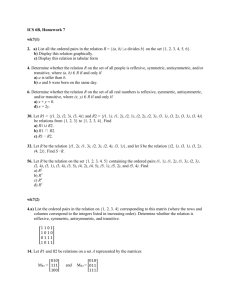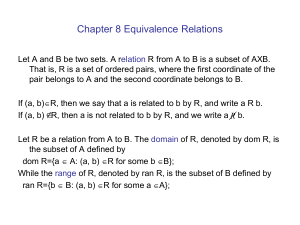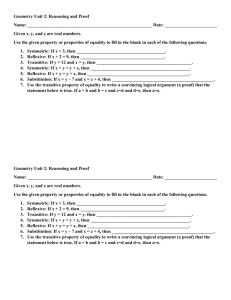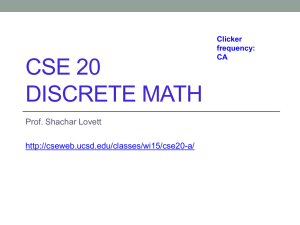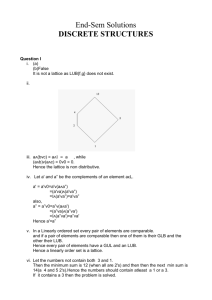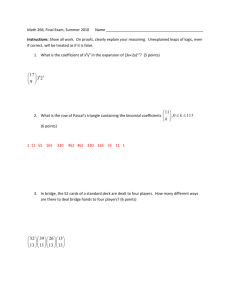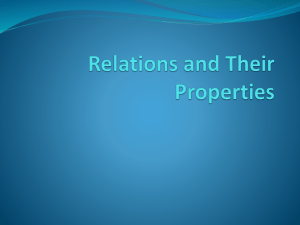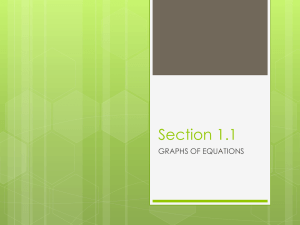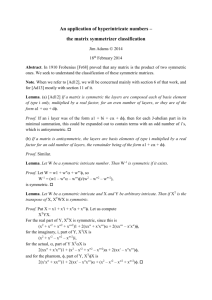cs310-hw7model answer
advertisement
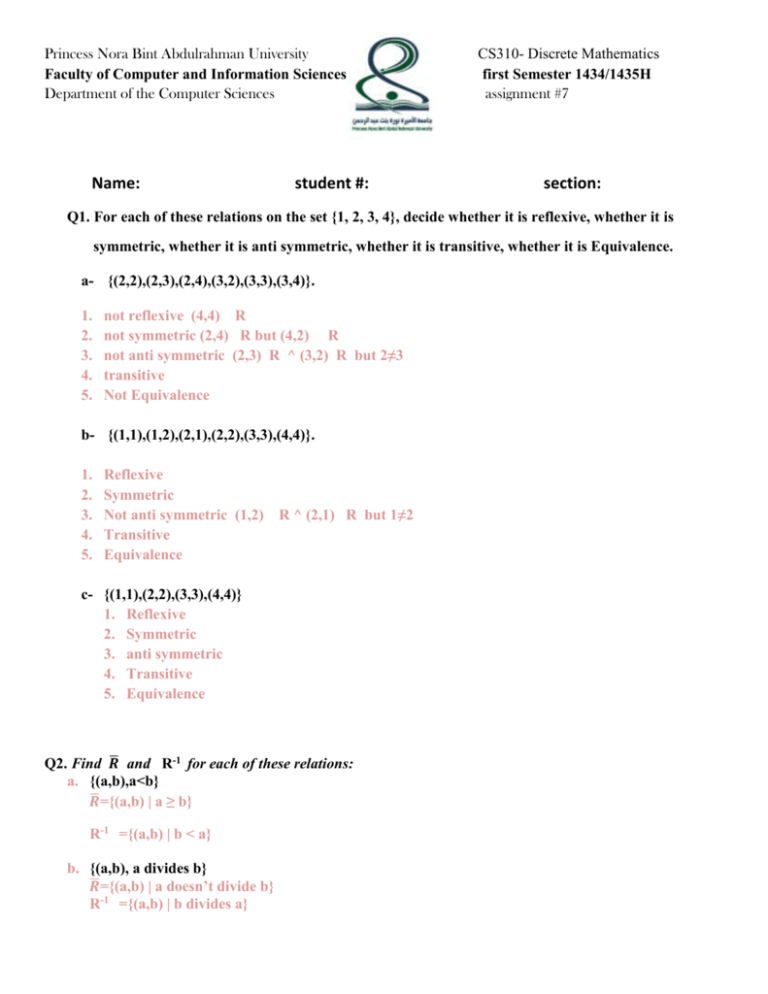
Princess Nora Bint Abdulrahman University
Faculty of Computer and Information Sciences
Department of the Computer Sciences
Name:
student #:
CS310- Discrete Mathematics
first Semester 1434/1435H
assignment #7
section:
Q1. For each of these relations on the set {1, 2, 3, 4}, decide whether it is reflexive, whether it is
symmetric, whether it is anti symmetric, whether it is transitive, whether it is Equivalence.
a- {(2,2),(2,3),(2,4),(3,2),(3,3),(3,4)}.
1.
2.
3.
4.
5.
not reflexive (4,4) R
not symmetric (2,4) R but (4,2) R
not anti symmetric (2,3) R ^ (3,2) R but 2≠3
transitive
Not Equivalence
b- {(1,1),(1,2),(2,1),(2,2),(3,3),(4,4)}.
1.
2.
3.
4.
5.
Reflexive
Symmetric
Not anti symmetric (1,2)
Transitive
Equivalence
R ^ (2,1) R but 1≠2
c- {(1,1),(2,2),(3,3),(4,4)}
1. Reflexive
2. Symmetric
3. anti symmetric
4. Transitive
5. Equivalence
̅ and R-1 for each of these relations:
Q2. Find 𝑹
a. {(a,b),a<b}
̅ ={(a,b) | a ≥ b}
𝑹
R-1 ={(a,b) | b < a}
b. {(a,b), a divides b}
̅ ={(a,b) | a doesn’t divide b}
𝑹
R-1 ={(a,b) | b divides a}
Princess Nora Bint Abdulrahman University
Faculty of Computer and Information Sciences
Department of the Computer Sciences
CS310- Discrete Mathematics
first Semester 1434/1435H
assignment #7
Q3. Let A = {1, 2, 3}, B = {a, b, c}, and C = {x, y, z}. Consider the following relations R and S from A
to B to C, respectively.
R = {(1,b), (2,a), (2,c)} and
S = {(a, y), (b, x), (c, y), (c, z)}
a- Find the composition relation S o R.
S o R = { (1,x) , (2,y) , (2,z) }
R0S= { }
b- Find the matrices MR , MS and MRoS
Q4. Let A = {1, 2, 3, 4}. Consider the following relations R on A.
R ={(1, 1), (1, 2), (1, 3), (2, 4), (3, 2)}, Find R3.
R1={(1,1),(1,2),(1,3),(2,4),(3,2)}
R2=RoR= {(1,1),(1,2),(1,3),(1,4),(3,4)}
R3=R2oR= {(1,1),(1,2),(1,3),(1,4)}
Q5. Determine whether the relations represented by the directed graph are:
reflexive, symmetric, anti symmetric, transitive
Princess Nora Bint Abdulrahman University
Faculty of Computer and Information Sciences
Department of the Computer Sciences
a-
CS310- Discrete Mathematics
first Semester 1434/1435H
assignment #7
b-
a- \
1. Not Reflexive (no loop)
2. Not Symmetric ( there is edge from a to b but not from b to a , there is edge from a to c but not
from c to a).
3. Not anti symmetric (there is edge from b to c and there is from c to b but b ≠ c).
4. Not Transitive ( there is edge from c to b and from b to c , but not from b to b).
b- \
1. Reflexive
2. Not Symmetric ( there is edge from c to a but not from a to c , there is edge from c to d but not
from d to c).
3. Not anti symmetric (there is edge from a to b and there is from b to a).
4. Not Transitive (there is edge from c to a and there is from a to b but not from c to b).
Q6. Let R be the relation on the set { 0,1,2,3 } containing the ordered pairs
(0,1),(1,1),(1,2),(2,0),(2,2),(3,0) . Find the:
a- Reflexive closure of R.
{(0,1),(1,1),(1,2),(2,0),(2,2),(3,0) } ∪ {(0,0), (3,3)}
b- Symmetric closure of R.
{(0,1),(1,1),(1,2),(2,0),(2,2),(3,0) } ∪ {(1,0) , (2,1) , (0,2) , (3,0)}
Princess Nora Bint Abdulrahman University
Faculty of Computer and Information Sciences
Department of the Computer Sciences
CS310- Discrete Mathematics
first Semester 1434/1435H
assignment #7
Q7 . Which of these collections of subsets are partitions of {1,2,3,4,5,6}:
a- {1,2} , {2,3,4} , {4,5,6}.
No , because 4 and 2 appear in two sets
b- {1} , {2,3,6} , {4} , {5}.
Yes , because :
these sets are disjoint
the union of these sets is {1,2,3,4,5,6}.
c- {1,4,5} , {2,6}.
No , because the union of these sets is not {1,2,3,4,5,6} [ 3 not member of any subsets ].
